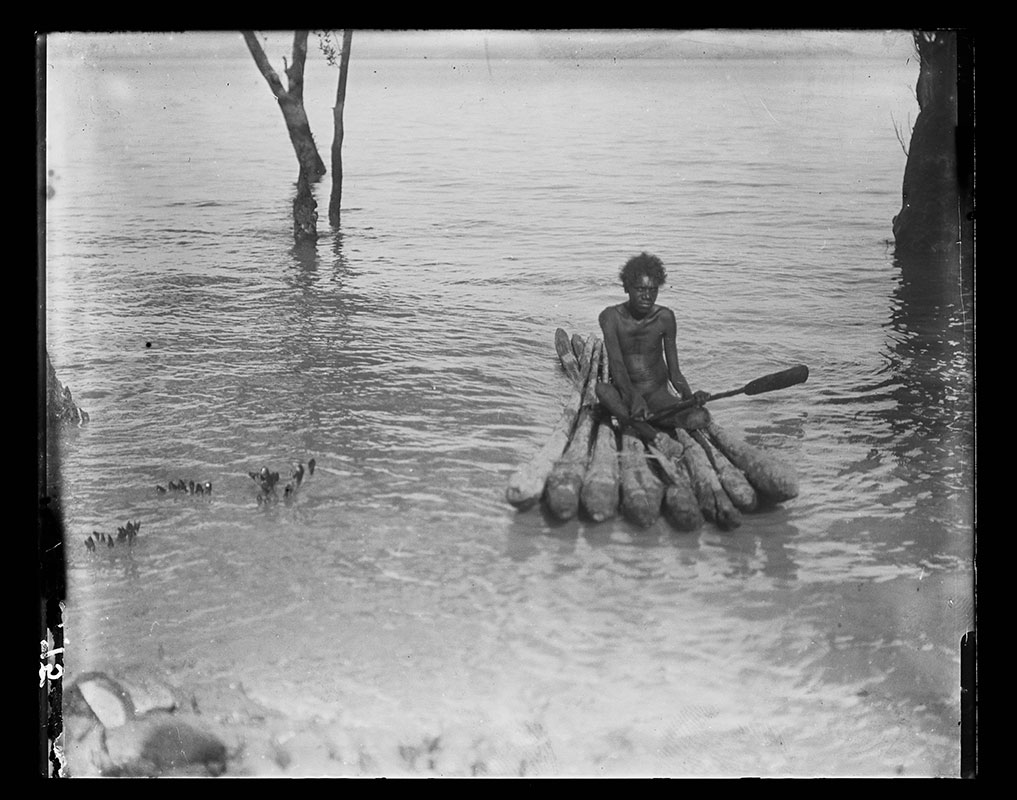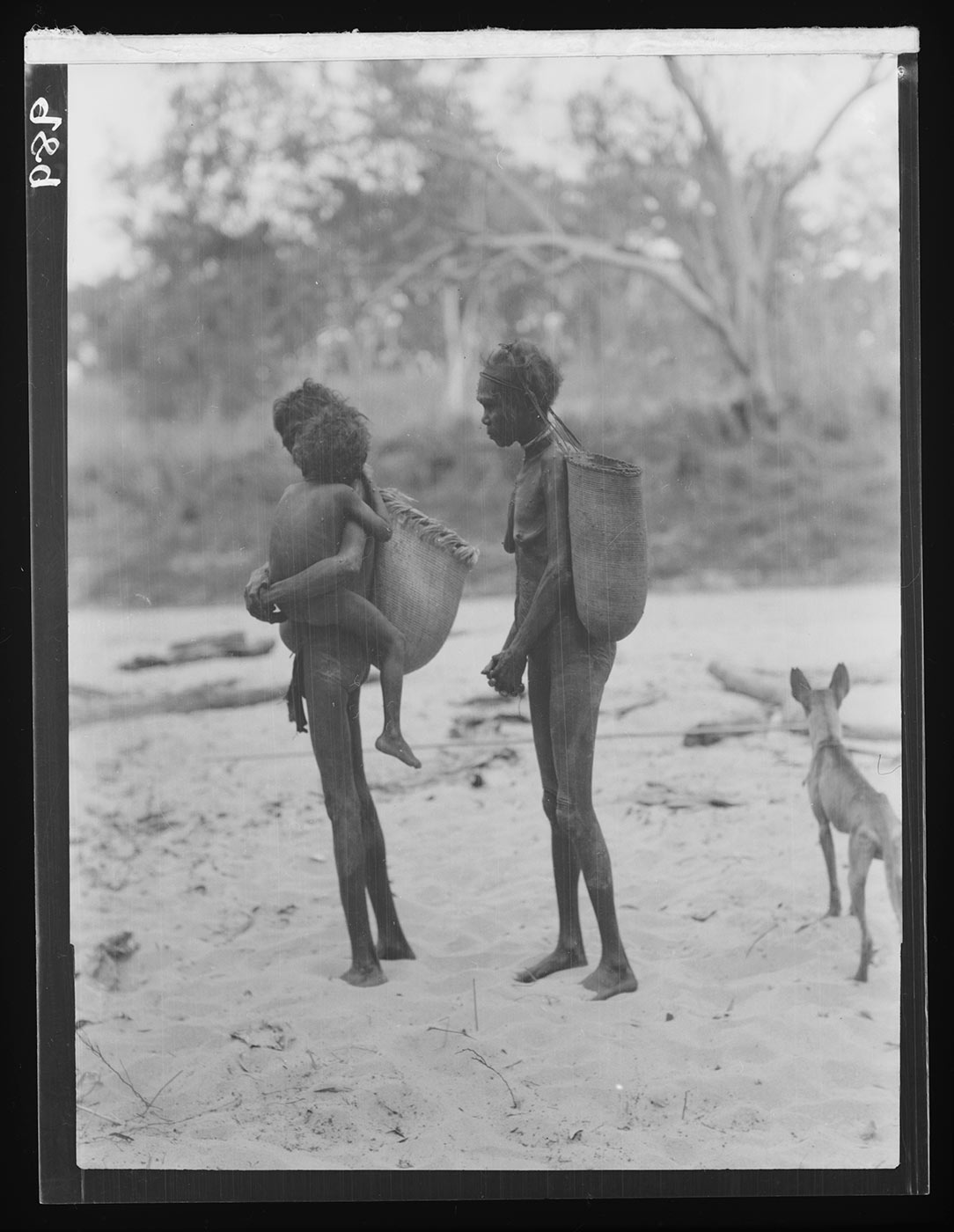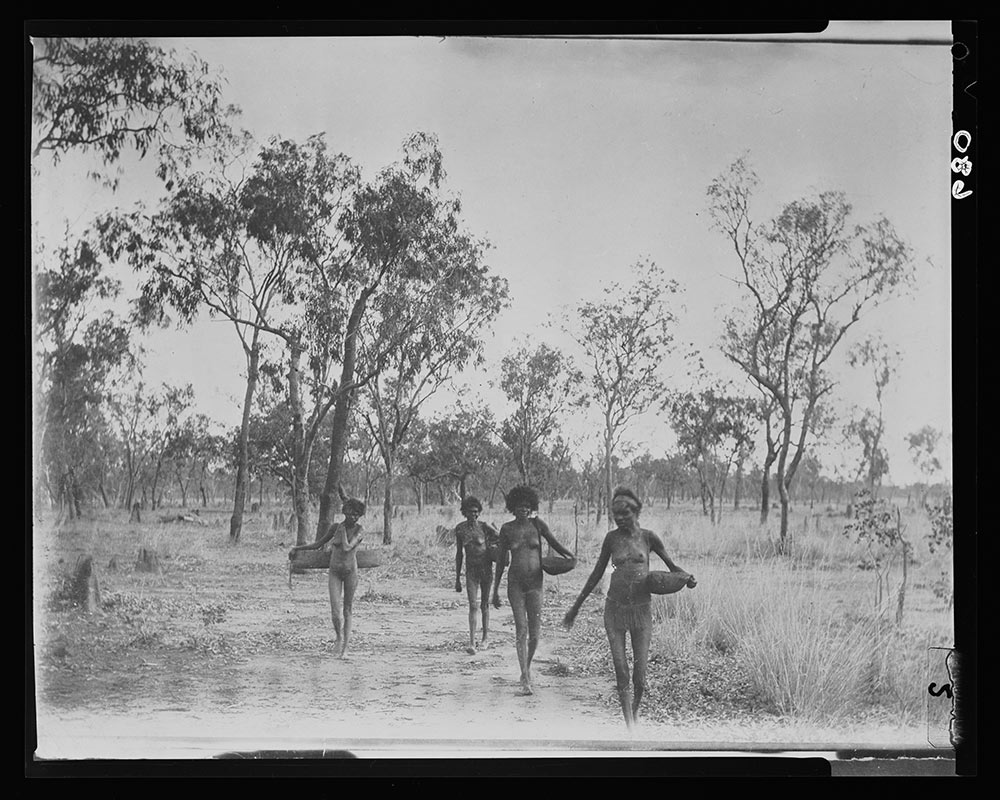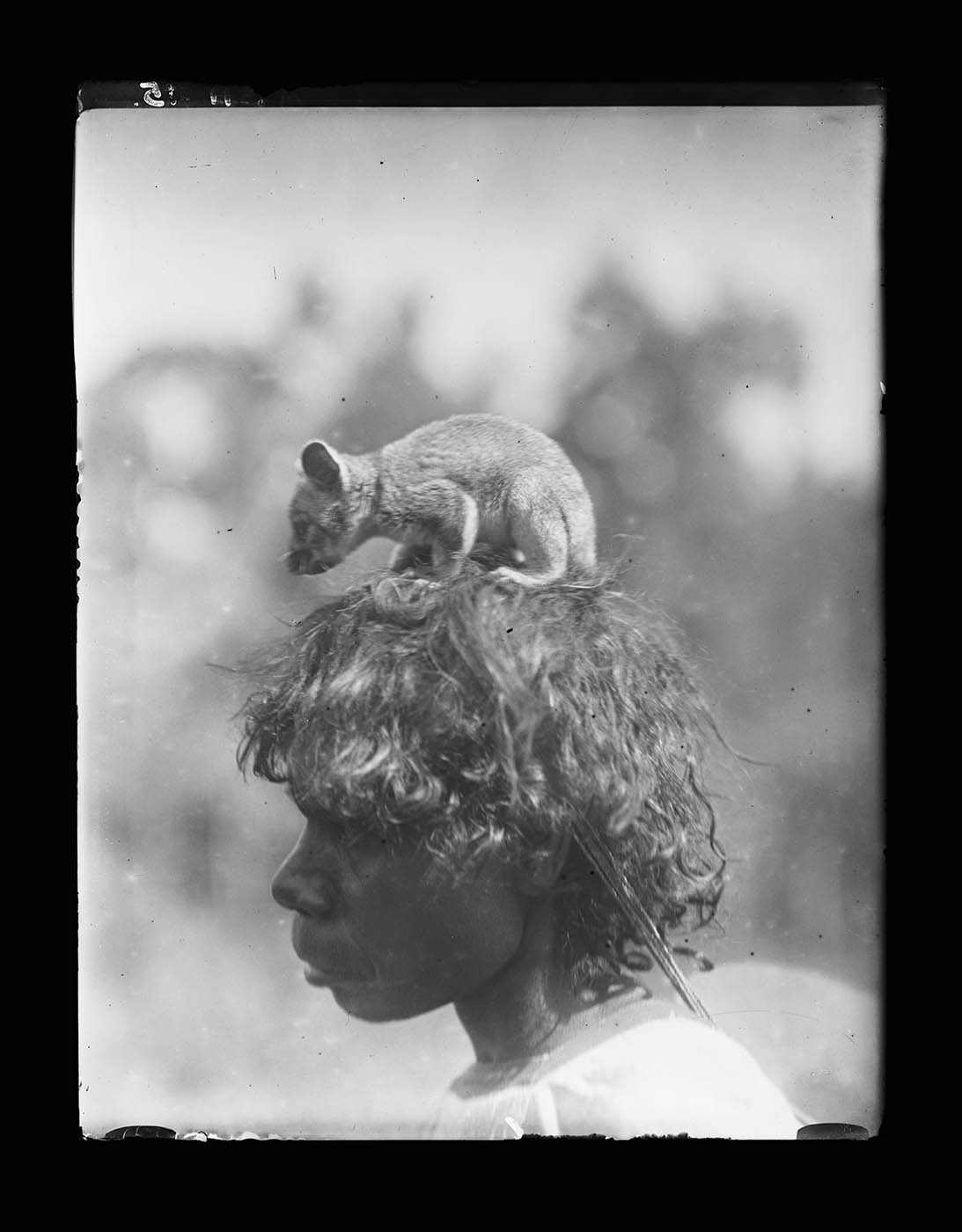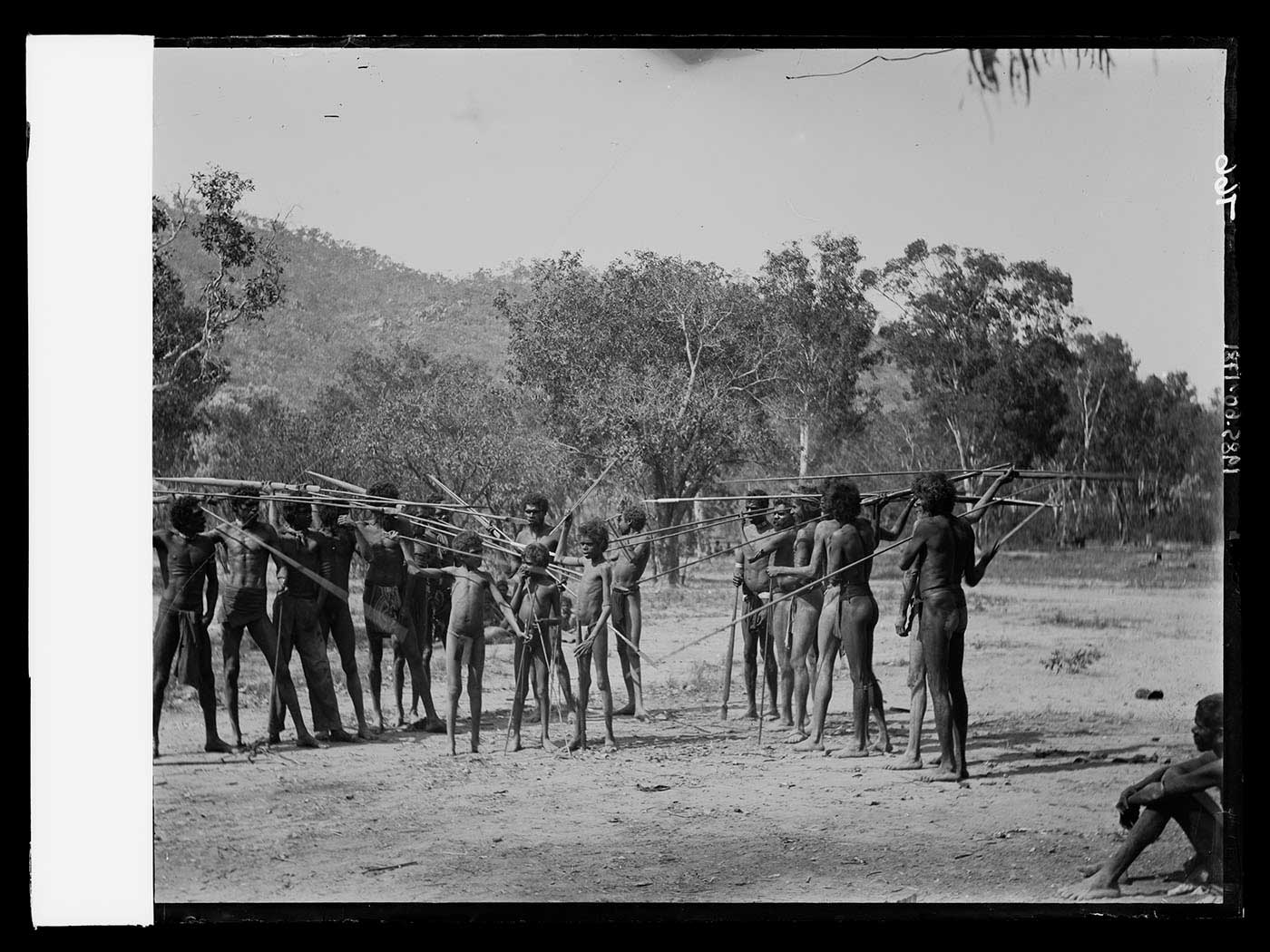Learning activities
In the activities described below, students compare the system of food procurement and preparation in their home life with that of Aboriginal families in the early 20th century, and experiment with using and making a string bag.
Materials
- 5-minute video about the string bag
- historical images of Aboriginal people taken in the early decades of the twentieth century (click on the images below to enlarge for printing or display).
Preparation
With your students, watch the video 'What is this? String bag'.
Print the photographs of Aboriginal people procuring and preparing food. The slideshow images are drawn from the National Museum's collection database and you may find the accompanying text useful for understanding the scenes and activities depicted.
The opening of the video shows a rainbow stripes moving across the screen from left to right. A cloud shape pops into the coloured stripes containing an image of a small net bag. The video title 'What is this' is superimposed on the bag. A question mark bounces into position at the end of the text ('What is this?') and an eyeball rolls around in the dot forming the bottom of the question mark and winks. Upbeat music plays in the background. A swarm of question marks moves across and fills the frame.
Cut to a close-up of a desk and two hands dropping a pile of books onto the desk.
On the left, Angela the presenter stands behind the desk. The pile of books is in front of her. Teddy the puppet is on the right. Above Teddy in the top right of the frame is an animated television graphic with spinning question marks on the screen.
ANGELA: (exhausted) Ooh. What an armful!
TEDDY: Hi, Angela. It looks like you need something to carry all those books and folders.
ANGELA: Hi, Teddy. I think you're right. If only I could've found a bag when I left home today.
TEDDY: What about … this?
(Teddy disappears from view, going behind the desk, and re-emerging with a small bag which he gives to Angela. She holds the bag up from its handle.)
TEDDY : I think it's some kind of bag. But it doesn't look quite the same as the ones I've seen at the shops.
ANGELA: Hmm ... interesting. What makes you say that, Teddy?
(Close-up of bag. Camera pans down the bag from handle.)
TEDDY: For a start, it's a lot smaller than a shopping bag. It's only about the size of a big lunch box. And …
(Teddy runs his paw across the surface of the bag.)
TEDDY: … oh, it feels quite different. It's made from some kind of string that's quite rough.
ANGELA: Anything else?
TEDDY: The string is in lots of little loops. And it's got some very earthy colours on it. They're not as bright as the ones in my paintbox, though.
ANGELA: Let me show you something, Teddy.
(Angela puts the bag on the desk. She reaches below the desk and produces a small tree branch with long thin, green leaves. She leans on the desk and holds the branch in front of Teddy. The camera pans across branch showing the branch and leaves in detail.)
ANGELA: Do you know what this is?
TEDDY: Yes, it's a piece of a plant.
ANGELA: Uh huh.
TEDDY: Can I touch?
(Teddy touches the leaves.)
ANGELA: Sure. What does it feel like?
TEDDY: The leaves are a bit papery and their edges are pointy.
ANGELA: It comes from a kurrajong tree. This, and many other kinds of plants, can be used to make threads.
TEDDY: Really? That's amazing!
ANGELA: Aboriginal people have been using threads made from plants to weave bags just like this for thousands of years.
(Angela picks up bag.)
TEDDY: How do they make the colours, Angela?
ANGELA: Well, coloured dyes can be made using different coloured clays, ash from fires, mashing up plant roots ... whatever you could find locally to stain the threads.
TEDDY: So the bags might look different in different parts of the country.
ANGELA: That's right. Now, how do you think the people who made these bags used them, Teddy?
TEDDY: I like to carry my bag over my shoulder. But the handle on this bag looks too small to do that.
ANGELA: Do you have a backpack, Teddy?
TEDDY: Yes. It's great when I need to carry stuff and keep my hands free.
ANGELA: That's exactly how these string bags were used. By putting the handle around your head ... like this ...
(Angela places the long handle of the across her forehead so that the bag hangs down her back.)
TEDDY: Oh! Just like a headband.
ANGELA: ... your hands were free to do other things.
(Angela spreads her hands out and turns around so that bag can be clearly seen hanging down her back.)
TEDDY: What kinds of things, Angela?
ANGELA: Well, Teddy. When you're wearing your backpack, what other things can you do?
TEDDY: I can ride my bike, or I can help my Mum get things out of the car.
(Angela has taken the bag off her head and holds it up by its handle, and then places it on the desk in front of her.)
ANGELA: And what do you use bags for?
TEDDY: To hold my water bottle and my lunch box. And my Mum uses bags when she goes to the supermarket. Did Aboriginal people use these bags for that too?
ANGELA: They certainly used string bags to carry food. Traditionally, Aboriginal people didn't get their food from supermarkets, though. Where do you think they got it from, Teddy?
TEDDY: Um ... Oh! Maybe they grew their food, like my Nan. She has a veggie garden so she doesn't have to go to the shops as much.
ANGELA: In the past, a long time before there were shops, Aboriginal people gathered food from the environment around them.
TEDDY: And you'd need both hands to do that. And somewhere to put the food while you kept gathering. Wow! We can find out lots of stuff just by looking at this string bag.
ANGELA: That's right, Teddy. And there are many ways of finding stories about different objects. The trick is to look closely and be curious!
TEDDY: So it's okay for me to ask heaps of questions?
ANGELA: Sure. Asking questions about what we're looking at is a terrific way of discovering stories.
TEDDY: That's good, because I like asking questions.
ANGELA: I've noticed.
TEDDY: Oh, oh, oh, oh, oh! I've got another question. Would you like a hand carrying all your stuff? I don't think all of your books will fit in the string bag.
ANGELA: That'd be great, Teddy. And anyway, we have to leave the string bag here.
(Angela picks up a pile of books from the desk.)
TEDDY: (waving) Bye-bye everybody.
ANGELA: See you later.
TEDDY: Uh-oh! On second thoughts ... I'll just watch.
ANGELA: Mmm-hmm ... I thought you might.
(Angela walks off.)
TEDDY: I'm only little ... and those books are so big.
Upbeat music. An animation of rainbow stripes moving across the screen from left to right. A cloud shape pops into the coloured stripes containing an image of a small net bag. The video title 'What is this?' is superimposed on the bag. This dissolves to National Museum of Australia logo.
1. Obtaining food and water — exploration
Activities
Discuss with the class how in their family they obtain water and food:
- Where does your food come from? Who finds it, and how do they carry it home? Do you use a string bag like in the video, or something else?
- Where does your drinking water come from? Does anyone have a well? A water tank?
- Does anyone have a vegetable garden?
- Does anyone know where the food in the supermarket comes from? How does it get to the supermarket?
- How many people do you live and eat with? Find out who has the smallest household and who has the largest. Does anyone live with their grandparents, or an aunt or uncle, or someone to whom they're not related by blood (for example, a step-parent or friend)?
- In your home, who prepares the meals? Do you help with food preparation?
- Do you share your home with any animals?
Explain to the students that you're going to show them some photographs of Aboriginal people obtaining food for their family, and that they were all taken about 100 years ago. (Make sure that everyone has a sense of 100 years ago — that's probably around the time when your great-great-grandparents were born, or your mum’s mum's mum's mum.)
Show the photograph of women carrying water. Explain that the women are carrying water and ask the students to consider: where do you think the people's drinking water comes from? Can you imagine carrying your drinking water in a wooden container like that?
Show these three photographs and explain that they are all of people looking for food:
- young man on a mangrove tree raft
- men and boys preparing for an emu hunt
- women carrying large baskets and a child
Ask the students what they think the people ate. Does anyone in your family go fishing or hunting? Does anyone collect fruit or nuts or vegetables from the garden? From the bush? Recall the discussion of family structures, who brings the food home and who prepares the meals. Can you notice anything in these photographs that is the same as your home life? How many differences can you spot?
2. Carrying a bag on your head
Activities
Bring to class a string bag and some fruit to share. If you can't find an actual string bag, any shopping bag that could be worn on your head will do. Show students these two photographs of women carrying a bag on their head:
Put the fruit in the bag and invite the students to try carrying it around their head. How much fruit is comfortable to carry? Afterward, share the fruit and encourage students to share questions that this exercise generated for them.
3. Making or drawing a fibre bag or basket
Activities
Explain to students that it is possible to make beautiful bags and baskets from plant fibres and dyes, such as these in the collection of the National Museum of Australia:
Sometimes wool was also used:
Make sure students understand that Aboriginal women are still making beautiful bags and baskets today. For clues about how they do it, look at the following pages from the Bula'bula Arts website, in Arnhem Land, east of Darwin.
Take the students for a walk to where there is some long grass or reeds. See if you can find some fibres or reeds that you might be able to use to create a small vessel or bag. Experiment with weaving or knotting to make a segment of fabric or — if you are really good at it — a vessel that might hold some weight.
Then invite students to draw a string bag or basket. What foods might they find in their neighbourhood to collect? Draw or list the foods they might find — or might like to find.
Explore more on What is this?
Explore more on What is this?
